LINCS News
Stay up to date with the latest news regarding the LINCS Consortium
2025 Summer Research Training Program in Biomedical Big Data Science
Posted on October 10th, 2024 by Heesu Kim

We are currently accepting applications for the 2025 Summer Research Training Program in Biomedical Big Data Science, a research-intensive ten-week training program for undergraduate and master’s students interested in participating in cutting-edge research projects aimed at solving data-intensive biomedical problems. Summer fellows training in the Ma’ayan Laboratory conduct faculty-mentored independent research projects in the following areas: data harmonization, machine learning, cloud computing, and dynamic data visualization.
To apply, submit an application at the online application form.
Application Deadline: February 1, 2025 at 5:00 PM Eastern Time
Program Dates: June 2 – August 8, 2025
Formal Training Program Research Presentations and Trainees
Check out the presentations by our 2024 BD2K-LINCS DCIC Summer Research Fellows!
2024 Summer Research Training Program in Biomedical Big Data Science
Posted on January 5th, 2024 by Heesu Kim

We are currently accepting applications for the 2024 Summer Research Training Program in Biomedical Big Data Science, a research-intensive ten-week training program for undergraduate and master’s students interested in participating in cutting-edge research projects aimed at solving data-intensive biomedical problems. Summer fellows training in the Ma’ayan Laboratory conduct faculty-mentored independent research projects in the following areas: data harmonization, machine learning, cloud computing, and dynamic data visualization.
To apply, submit an application at the online application form.
Application Deadline: February 1, 2024 at 5:00 PM Eastern Time
Program Dates: June 3 – August 9, 2024
Formal Training Program Research Presentations and Trainees
Check out the presentations by our 2023 BD2K-LINCS DCIC Summer Research Fellows!
Publication Highlight | Dex-Benchmark
Datasets and code to evaluate algorithms for transcriptomics data analysis
Posted on January 4th, 2023 by Heesu Kim

Xie et al.(2023) introduced the Dexamethasone Benchmark (Dex-Benchmark), published in PeerJ. The Dex-Benchmark resource can be utilized to assess the quality of transcriptomics and other related bioinformatics data analysis workflows. The Dex-Benchmark resource provides the datasets and code templates for benchmarking different gene expression analysis tools and algorithms. You can access a collection of curated RNA-seq, L1000, and ChIP-seq data from dexamethasone treatment as well as genetic perturbations of its known targets. Dex-Benchmark provides the code template in Jupyter Notebooks format to leverage and ease the use of pre-processed and curated datasets to demonstrate how to benchmark the different steps in gene expression analysis.
The resource is available from: https://maayanlab.github.io/dex-benchmark.
Xie Z, Chen C, Ma'ayan A. Dex-Benchmark: datasets and code to evaluate algorithms for transcriptomics data analysis PeerJ. 2023 Nov 8;11:e16351. doi: 10.7717/peerj.16351. PMID: 37953774
Follow @MaayanLabFollow @BD2KLINCSDCICFollow @LINCSProgramPublication Highlight | ReproTox-KG
Knowledge graph that integrates evidence about genes and drugs associated with birth defects
Posted on September 7th, 2023 by Heesu Kim

In a recent LINCS-related publication, Evangelista et al. introduce the reproductive toxicity knowledge graph (ReproTox-KG). The aim of this publication, published in Communications Medicine, is to investigate the links between birth defects, drugs, and genes to assess the potential of pre-clinical compounds to induce specific birth abnormalities. By integrating data from multiple sources, including LINCS L1000 data, predictions are made for over 30,000 small molecules about their potential to cross the placenta and cause birth defects. The study also employs graph theory algorithms to identify more than 500 birth-defect/gene/drug cliques which can be used to explain molecular mechanisms for drug-induced birth defects.
Evangelista JE, Clarke DJB, Xie Z, Marino GB, Utti V, Jenkins SL, Ahooyi TM, Bologa CG, Yang JJ, Binder JL, Kumar P, Lambert CG, Grethe JS, Wenger E, Taylor D, Oprea TI, de Bono B, Ma'ayan A. Toxicology knowledge graph for structural birth defects. Commun Med (Lond). 2023 3(1):98. doi: 10.1038/s43856-023-00329-2. PMID: 37460679
Follow @MaayanLabFollow @BD2KLINCSDCICFollow @LINCSProgramPublication Highlight | MOBILE
Multi-Omics Binary Integration via Lasso Ensembles to Infer Cell Signaling Pathways
Posted on September 6th, 2023 by Heesu Kim

The Multi-Omics Binary Integration via Lasso Ensembles (MOBILE) is a computational pipeline that was developed to nominate molecular features associated with cellular phenotypes and pathways. LINCS investigators applied MOBILE to MCF10A dense cube data to suggest mechanisms for interferon-γ (IFNγ) regulation of PD-L1 expression. The analysis suggests that IFNγ-controlled PD-L1 expression involves the intermediate proteins BST2, CLIC2, FAM83D, ACSL5, and HIST2H2AA3. The study also compares networks activated by the transforming growth factor-beta 1 (TGFβ1) and bone morphogenetic protein 2 (BMP2). It finds that differences in ligand-induced changes in cell size and clustering properties are related to differences in laminin/collagen pathway activity. Finally, the authors demonstrate the broad applicability and adaptability of MOBILE by analyzing publicly available molecular datasets to investigate breast cancer subtype-specific networks.
Erdem C, Gross SM, Heiser LM, Birtwistle MR. MOBILE pipeline enables identification of context-specific networks and regulatory mechanisms. Nat Commun. 2023 Jul 6;14(1):3991. doi: 10.1038/s41467-023-39729-2. PMID: 37414767
Follow @BirtwistleLabFollow @LINCSProgramPublication Highlight | Saracatinib as a potential therapeutic for atherosclerosis
Systems immunology-based drug repurposing framework to target inflammation in atherosclerosis
Posted on September 5th, 2023 by Heesu Kim

In a recent study published in Nature Cardiovascular Research by Amadori et al. the Phase 2 clinical trials compound saracatinib was identified as a potential drug for the treatment of atherosclerosis. The study integrates mass cytometry data (CyTOF) with RNA sequencing data to identify inflammatory signatures in blood cells stimulated by plasma from atherosclerotic cardiovascular disease (ASCVD) patients. By comparing these signatures with the large-scale gene expression LINCS L1000 dataset, the study identified drugs that can reverse the inflammatory response. Saracatinib is shown to reduce atherosclerosis progression and plaque inflammation in several in-vitro and in-vivo preclinical models. The study emphasizes the need for immunomodulatory treatments to target the inflammatory mechanisms of ASCVD and highlights the potential of drug repurposing in cardiovascular therapy.
Amadori L, Calcagno C, Fernandez DM et al. Systems immunology-based drug repurposing framework to target inflammation in atherosclerosis.Nat Cardiovasc Res 2, 550–571 (2023). doi: 10.1038/s44161-023-00278-y
Follow @GiannarelliLabFollow @MaayanLabFollow @BD2KLINCSDCICFollow @LINCSProgramPublication Highlight | MCF10A
Resource for integrative assessment of ligand-mediated molecular and phenotypic responses
Posted on May 30th, 2023 by Heesu Kim

Gross et al. (2022) demonstrated in a publication in Communications Biology how MCF10A cells respond to a variety of extracellular ligands at the multi-layered omics level. The study introduces a comprehensive dataset that catalogs the transcriptional, proteomic, epigenomic and phenotypic responses of MCF10A mammary epithelial cells after exposure to the ligands EGF, HGF, OSM, IFNG, TGFB and BMP2. Systematic assessment of the molecular and cellular phenotypes induced by these ligands comprise the LINCS Microenvironment perturbation(MEP) DeepDive dataset, which has been curated and made publicly available for community-wide analysis, hypothesis generation, and development of novel computational tools.
Gross, SM. et al. A multi-omic analysis of MCF10A cells provides a resource for integrative assessment of ligand-mediated molecular and phenotypic responses.Commun Biol 5(1):1066. doi: 10.1038/s42003-022-03975-9 (2022). PMID: 36207580
Follow @LINCSProgram2020 Summer Research Training Program in Biomedical Big Data Science
Posted on October 23rd, 2019 by Sherry Jenkins
We are currently accepting applications for the 2020 Summer Research Training Program in Biomedical Big Data Science, a research intensive ten-week training program for undergraduate and graduate students. The BD2K-LINCS Data Coordincation and Integration Center supports data science research focused on developing methods that would further extract knowledge from LINCS data by integrating LINCS data with other relevant resources. Summer fellows training in the Ma'ayan Laboratory at the Icahn School of Medicine at Mount Sinai in New York City will conduct faculty-mentored independent research projects in the following areas: data harmonization, machine learning, cloud computing and dynamic data visualization.
How to Apply
Program Dates: June 1, 2020 - August 7, 2020
Check out the presentations by our 2019 BD2K-LINCS DCIC Summer Research Fellows!
Drug Gene Budger (DGB)
Posted on September 12th, 2019 by Sherry Jenkins
An application for ranking drugs to modulate a specific gene based on transcriptomic signatures
Developed by the BD2K-LINCS Data Coordination and Integration Center

DGB is a web-based and mobile application developed to assist investigators in prioritizing small molecules that are predicted to maximally influence the expression of their target gene of interest. With DGB, users can enter a gene symbol, and whether they wish to upregulate or downregulate its expression. The output of the application is a ranked list of small molecules that have been experimentally determined to produce the desired expression effect. The output table includes log-transformed fold change, p-value and q-value for each small molecule, reporting the significance of differential expression as determined by the limma method. Relevant links are provided to further explore knowledge about the target gene, the small molecule, and the source of evidence from which the relationship between the small molecule and the target gene was derived. The experimental data contained within DGB is compiled from signatures extracted from the LINCS L1000 dataset, the Gene Expression Omnibus (GEO), and the original Affymetrix Connectivity Map. DGB provides a useful preliminary technique for identifying small molecules that can target the expression of single genes in mammalian cells.
The Drug Gene Budger application is freely available at amp.pharm.mssm.edu/DGB/
Users can also download the free mobile application versions: DGB for iPhone and DGB for Android
Wang Z, He E, Sani K, Jagodnik KM, Silverstein MC, Ma'ayan A. Drug Gene Budger (DGB): an application for ranking drugs to modulate a specific gene based on transcriptomic signatures. Bioinformatics 2019. PMID: 30169739
Follow @BD2KLINCSDCICBD2K-LINCS DCIC Summer Research Training Program in Biomedical Big Data Science
Posted on September 12th, 2019 by Sherry Jenkins
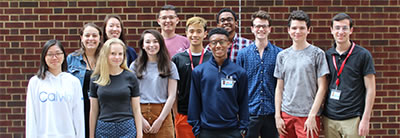
On the final day of the ten-week training program, the Ma'ayan Laboratory and the BD2K-LINCS DCIC hosted a special presentation session featuring the research projects of the summer fellows in the 2019 BD2K-LINCS DCIC Summer Research Training Program in Biomedical Big Data Science. Summer fellows conducted faculty-mentored independent research projects within the Ma'ayan Laboratory at the Icahn School of Medicine at Mount Sinai in the following areas: data harmonization, machine learning, cloud computing, and dynamic data visualization. The DCIC supports data science research focused on developing methods that would further extract knowledge from LINCS data by integrating LINCS data with other relevant resources. Our data science projects address methodological and computational challenges related to such integrative analyses.
Program Description
Video Summaries of Research Projects
LINCS Connectivity Map Workshop Series
Posted on November 30, 2018 by Sherry Jenkins
CLUE Workshop 2018

The NIH LINCS Program and the Connectivity Map at the Broad Institute are hosting training workshops on the analysis of large-scale perturbational datasets for biological applications. During the December workshop, a suite of training modules aimed at users of L1000 and LINCS data will be offered. Sessions led by members of the LINCS Transcriptomics Center and the BD2K-LINCS DCIC will include:
- CMAP Data Access and Resources
- The Next 2M Profiles
- Integrative Connectivity Map
- L1000 CRISPR
- Data Visualization and Emerging Analysis Tools
- Connectivity Map Case Studies
BD2K-LINCS DCIC 2019 Summer Research Training Program in Biomedical Big Data Science
Posted on October 11th, 2018 by Sherry Jenkins
We are currently accepting applications for the BD2K-LINCS DCIC 2019 Summer Research Training Program in Biomedical Big Data Science, a research intensive ten-week training program for undergraduate and graduate students. The BD2K-LINCS Data Coordincation and Integration Center supports data science research focused on developing methods that would further extract knowledge from LINCS data by integrating LINCS data with other relevant resources. Summer fellows training in the Ma'ayan Laboratory at the Icahn School of Medicine at Mount Sinai in New York City will conduct faculty-mentored independent research projects in the following areas: data harmonization, machine learning, cloud computing and dynamic data visualization.
How to Apply
Program Dates: June 3, 2019 - August 9, 2019
Check out the presentations by our 2018 BD2K-LINCS DCIC Summer Research Fellows!
Publication Highlight | Broad Transcriptomics
A Next Generation Connectivity Map
Posted on December 21th, 2017 by Alexandra B. Keenan
Subramanian et al. (2017) in a recent publication in Cell describe a massive scaling up of the Connectivity Map (CMap) to 1.3 million gene expression profiles using the L1000 technology, a low-cost high-throughput hybridization assay that is comparable to microarrays and RNA-seq. The authors demonstrate that expression signatures obtained from 19,811 small molecules and 5,075 genetic perturbations can be used to functionally annotate unknown small molecules and genetic variants of disease causing genes. Tools and signatures are available at CLUE, the LINCS Data Portal, and some of the same signatures are available for search from L1000CDS2.
Subramanian, A. et al. A Next Generation Connectivity Map: L1000 Platform and the First 1,000,000 Profiles. Cell 171, 1437-1452 e1417, doi:10.1016/j.cell.2017.10.049 (2017). PMID: 29195078
Follow @LINCSProgramShare on TwitterPublication Highlight | LINCS Joint Project
Common and cell-type specific responses to anti-cancer drugs
Posted on December 21th, 2017 by Alexandra B. Keenan
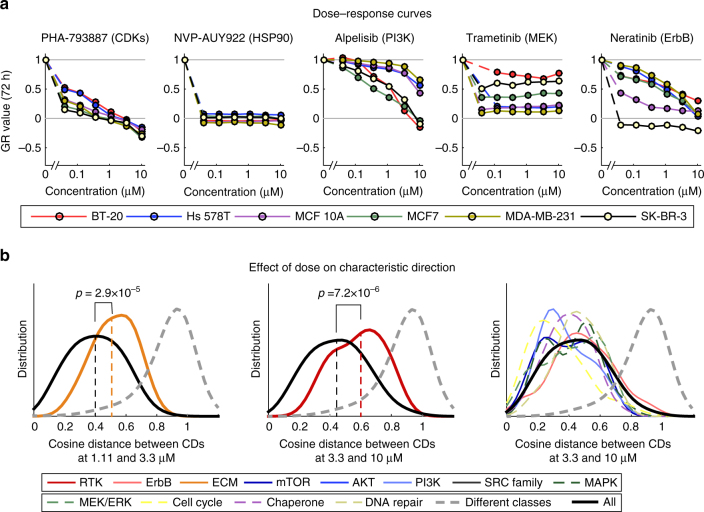
In a related study published recently in Nature Communications, Niepel et al. (2017) combined L1000 expression signatures together with cell growth phenotypes for over 600 drug-cell line combinations. The study demonstrates that phenotypic responses and transcriptional changes generally correlate across cell lines treated with anti-cancer drugs. However, while chaperone and cell cycle kinase inhibitors induce similar transcriptional changes across cell lines, intra-cellular signaling kinase inhibitor responses are cell-type specific. In addition, the study demonstrates how drug combinations to combat resistance can be inferred from single drug expression signatures combined with cell viability measures.
The LINCS Joint Project-Breast Cancer Network Browser (LJP-BCNB) is an interactive visualization of 2344 signatures created from this dataset.
Niepel, M. et al. Common and cell-type specific responses to anti-cancer drugs revealed by high throughput transcript profiling. Nat Commun 8, 1186, doi:10.1038/s41467-017-01383-w (2017). PMID: 29084964
Follow @LINCSProgramShare on TwitterPublication Highlight | LINCS Consortium
A LINCS Program Review
Posted on December 21th, 2017 by Alexandra B. Keenan
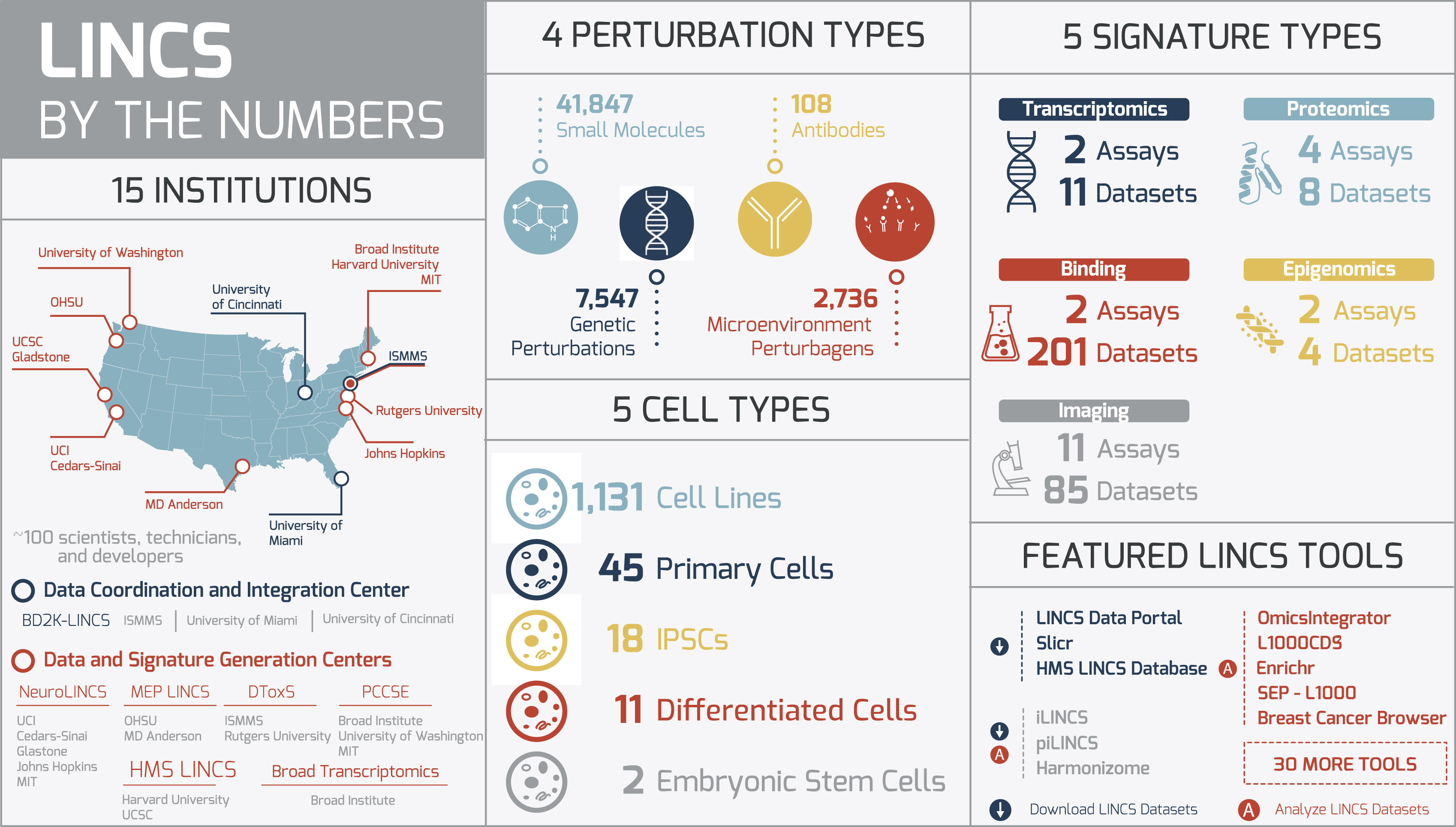
The LINCS Consortium (Keenan et al., 2017) has published the first comprehensive review that describes the various parts of the LINCS program. The article, published in Cell Systems, aims to broadcast the availability of LINCS tools and datasets, targeting experimental and computational biologists. The review encompasses the LINCS program vision, describes publicly available datasets, where the datasets are located, how they were generated, and the tools available for analysis of these datasets.
Keenan, A. B. et al. The Library of Integrated Network-Based Cellular Signatures NIH Program: System-Level Cataloging of Human Cells Response to Perturbations. Cell Syst, doi:10.1016/j.cels.2017.11.001 (2017). PMID: 29199020
Follow @LINCSProgramShare on TwitterPublication Highlight | BD2K-LINCS Data Coordination and Integration Center
LINCS Data Portal and LINCS Data Registry
Posted on December 21th, 2017 by Alexandra B. Keenan
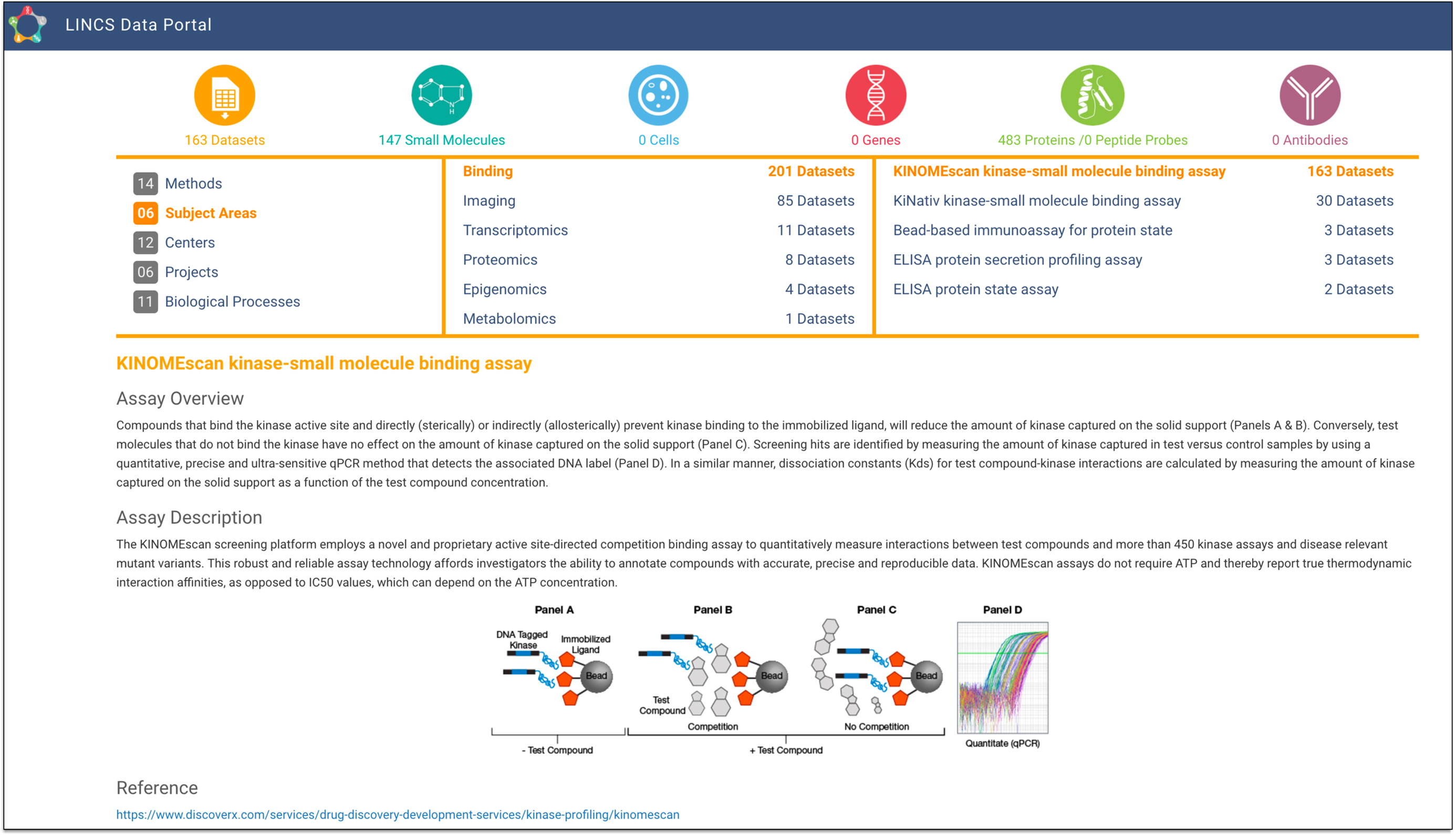
Koleti et al. (2017) highlight the features of the LINCS Data Portal in a recent publication in Nucleic Acids Research database issue. The LINCS Data Portal provides integrated access to LINCS data and analysis tools. The authors also describe the LINCS Data Registry which is designed to meet the challenges of integrating data and metadata from diverse assay technologies employed by the six LINCS Data and Signature Generation Centers (DSGCs).
Koleti, A. et al. Data Portal for the Library of Integrated Network-based Cellular Signatures (LINCS) program: integrated access to diverse large-scale cellular perturbation response data. Nucleic Acids Res, doi:10.1093/nar/gkx1063 (2017). PMID: 29140462
Follow @LINCSProgramShare on TwitterBD2K-LINCS DCIC 2018 Summer Research Training Program in Biomedical Big Data Science
Posted on October 5th, 2017 by Sherry Jenkins
We are currently accepting applications for the BD2K-LINCS DCIC 2018 Summer Research Training Program in Biomedical Big Data Science, a research intensive ten-week training program for undergraduate and graduate students. The DCIC supports data science research focused on developing methods that would further extract knowledge from LINCS data by integrating LINCS data with other relevant resources. Summer fellows conduct faculty-mentored independent research projects within laboratories affiliated with the Center in the following areas: dynamic data visualization, machine learning, data harmonization, computational drug discovery, metadata and APIs, knowledge modeling, Bayesian networks and statistical mining.
How to Apply
Program Dates: June 4, 2018 - August 10, 2018
Presentation by our 2017 BD2K-LINCS DCIC Summer Fellow Christopher Tseng
BD2K-LINCS Data Science Symposium 2018
Studying Systems Biology by Cellular Perturbations
Posted on September 12th, 2017 by Sherry Jenkins
Date: January 31 - February 2, 2018
The BD2K-LINCS Data Coordination and Integration Center (DCIC) and the University of Miami will host the third annual BD2K-LINCS Data Science Symposium (DSS 2018) on January 31 - February 2, 2018.
This annual symposium brings together experts in systems biology, data science, drug discovery and translational medicine from academia, industry and government to present their latest research and exchange new ideas and approaches in data driven biomedical research. The general theme of the symposium is the study of complex biological systems using large-scale cellular perturbation profiling and applications in drug development, translational biomedicine and environmental health. Talks will address a range of issues related to leveraging Big Data in translational research including integration, visualization, access, sharing, and reuse of data, software tools and the emerging NIH Big Data ecosystem. The program also provides a survey of data science research pertaining to the BD2K (Big Data to Knowledge) and LINCS (Library of Integrated Network-Based Cellular Signatures) consortia.
Follow @BD2KLINCSDCICBD2K-LINCS DCIC Summer Research Training Program in Biomedical Big Data Science
Posted on September 11th, 2017 by Sherry Jenkins

On the final day of the ten-week training program, the BD2K-LINCS DCIC hosted a special presentation session featuring the research projects of the summer fellows in the 2017 BD2K-LINCS DCIC Summer Research Training Program in Biomedical Big Data Science. Summer fellows conducted faculty-mentored independent research projects within laboratories affiliated with the Center in the following areas: dynamic data visualization, machine learning, and data harmonization.
Program Description
Video Summaries of Research Projects
Systems Pharmacology Symposium 2017
Systems Pharmacology Approaches Toward Innovative Treatments for Heart Failure
Posted on September 11th, 2017 by Sherry Jenkins
Date: September 29, 2017

Members of the DToxS Center will host the Systems Pharmacology Symposium 2017 at the Icahn School of Medicine at Mount Sinai. This one-day symposium, will bring together leading scientists from academia, industry, and regulatory agencies to discuss how modeling and simulation can be used in drug development, including for the early prediction of toxicity.
Follow @LINCSProgramData Standards Update
Posted on August 28th, 2017 by Sherry Jenkins
Metadata Standards – New Versions Released
Current Versions of Standards Released: 8-22-17
- Antibody reagents
- Cell lines
- Differentiated cells
- Embryonic stem cells
- iPSCs
- Nucleic acid reagents
- Other reagents
- Primary cells
- Proteins
- Small molecules
- Unclassified perturbagens
Please visit the data standards page for more details.Follow @LINCSProgram
ICSB 2017 Workshop on Drug Response Measurement and Analysis
Posted on August 7th, 2017 by Sherry Jenkins

HMS LINCS researchers delivered a workshop on Drug Response Measurement and Analysis at the International Conference on Systems Biology 2017. They presented the experimental and computational methods they developed to generate reproducible dose-response measurements across cell lines, as well as theoretical approaches to quantify the sensitivity of cells to single drugs and drug combinations.
Follow @LINCSProgramCellosaurus Adds Cross-References to the LINCS Data Portal
Posted on May 22nd, 2017 by Sherry Jenkins
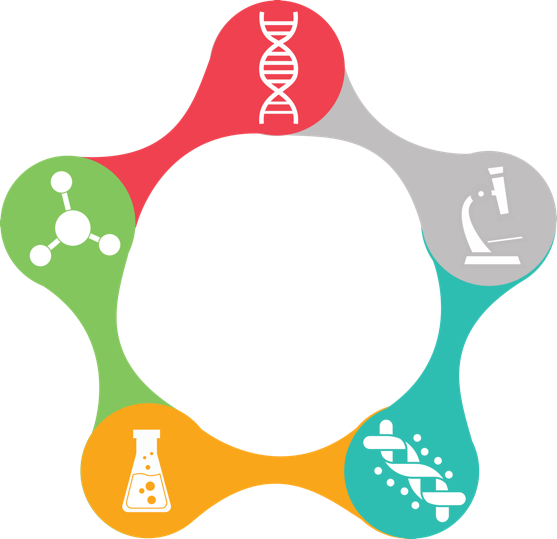
The Cellosaurus is the most complete curated online knowledge resource on immortalized cell lines, naturally immortal cell lines (for example, embryonic stem cells), finite life cell lines and vertebrate cell line with an emphasis on human, mouse and rat cell lines. The Cellosaurus is a participant of the Resource Identification Initiative. The Research Resource Identifiers (RRIDs) aim to promote the references to a community accepted and cross-referenced identifiers from authoritative community databases and vendors. Release 22 of the Cellosaurus was made available on ExPASy and includes cross-references to LINCS_LDP.
Follow @LINCSProgramBD2K-LINCS Data Science Symposium 2017
Systems Biology of Cellular Perturbations
Posted on February 23rd, 2017 by Sherry Jenkins
Date: May 16-18, 2017
The BD2K-LINCS Data Coordination and Integration Center (DCIC) and the University of Cincinnati Medical Center will host the second annual BD2K-LINCS Data Science Symposium (DSS 2017) on May 16-18, 2017.
The general theme of the symposium is the systems biology of perturbation signatures and applications in drug development, translational biomedicine and environmental health. Talks will address a range of issues related to leveraging Big Data in translational research including FAIR data principles and the emerging NIH Big Data ecosystem. The program will also provide a survey of data science research pertaining to BD2K (Big Data to Knowledge) and LINCS (Library of Network-Based Cellular Signatures) consortia. Details
Follow @BD2KLINCSDCICAACR Annual Meeting 2017 Special Session
Advancing Cancer Therapy Using Data from the NIH LINCS Program
Posted on February 14th, 2017 by Sherry Jenkins
Date: April 4, 2017, 5:00 - 6:30 PM
Location: Room 147, Level 1, Washington Convention Center, Washington, DC

Cancer cells respond to small molecule drugs and components of the microenvironment in a complex, time-dependent manner that varies from one cell type to the next and, within a genetically homogenous population, from one cell to the next. This session highlights recent results from the NIH-funded Library of Network- Based Cellular Signatures (LINCS) program, which is assembling libraries of perturbagen-response signatures using high-throughput transcript and proteomic profiling, live and fixed-cell imaging and phenotypic assays. Ways of accessing and analyzing LINCS data, software and experimental protocols will be presented along with recent insights into oncogenic mechanisms and responses to therapeutic drugs derived from large-scale profiling studies. Details
Follow @LINCSProgramPublication Highlight | HMS LINCS Center
Posted on January 24th, 2017 by Sherry Jenkins
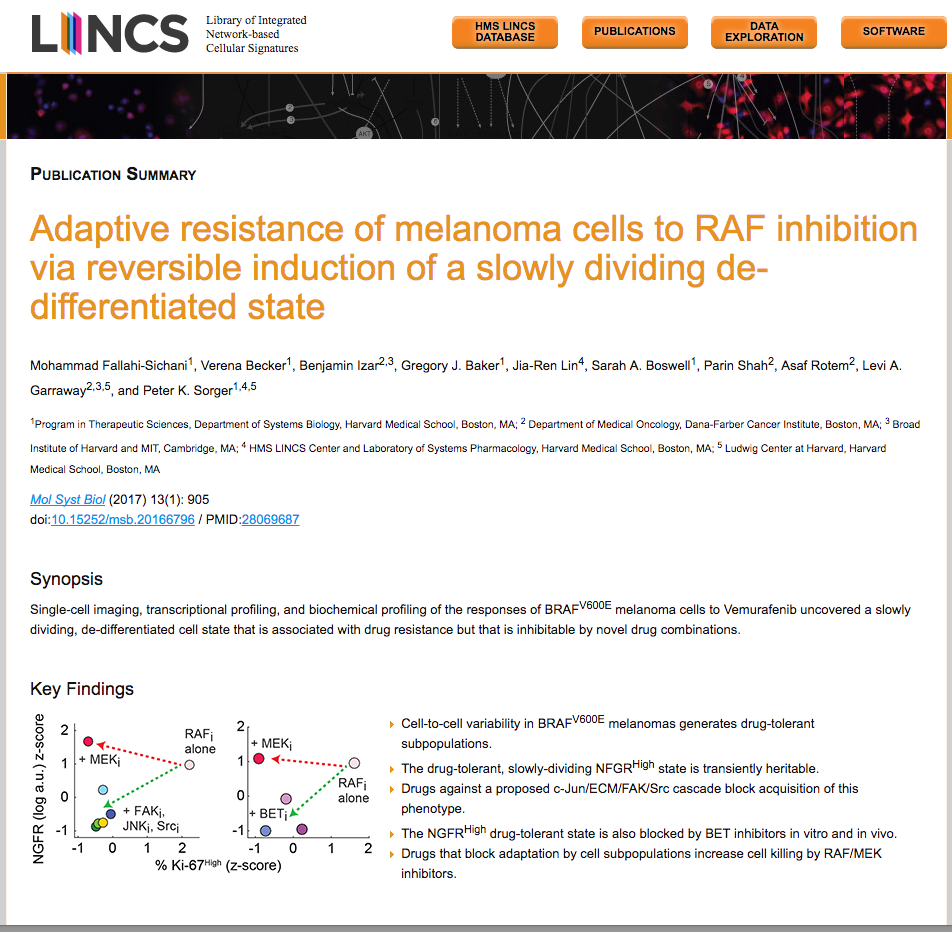
Adaptive resistance of melanoma cells to RAF inhibition via reversible induction of a slowly dividing de‐differentiated state
Fallahi-Sichani et al (2017) in Molecular Systems Biology uncovers a slowly dividing, de-differentiated subpopulation of Vemurafenib-treated BRAF(V600E) melanoma cells that is associated with drug resistance but inhibitable by novel drug combinations. Explore the publication as well as the associated datasets available in the HMS LINCS Database (#20272, #20273, #20274, #20275, #20276, #20277).
Fallahi-Sichani M, Becker V, Izar B, Baker GJ, Lin JR, Boswell SA, Shah P, Rotem A, Garraway LA, Sorger PK. Adaptive resistance of melanoma cells to RAF inhibition via reversible induction of a slowly dividing de‐differentiated state Mol Syst Biol. 2017 Jan 9;13(1):905. doi: 10.15252/msb.20166796 PMID: 28069687
Follow @LINCSProgramBD2K-LINCS DCIC at the 2016 BD2K All-Hands Meeting and Open Data Science Symposium
Posted on December 9th, 2016 by Sherry Jenkins
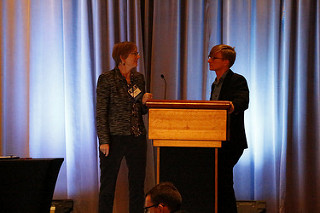
Members of the BD2K-LINCS Data Coordination and Integration Center participated in the BD2K All-Hands Meeting and Open Data Science Symposium in Bethesda, MD which took place on November 29 – December 1, 2016. The BD2K All-Hands Meeting brought together researchers, educators, developers, and trainees funded by the BD2K Initiative. The goals of the All-Hands Meeting were to showcase the work being done by BD2K-sponsored programs and to build a cohesive BD2K consortium that maximizes synergies between participants.
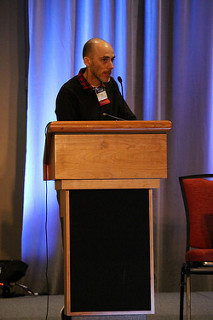
Publication Highlight | BD2K-LINCS Data Coordination and Integration Center
Posted on December 8th, 2016 by Sherry Jenkins
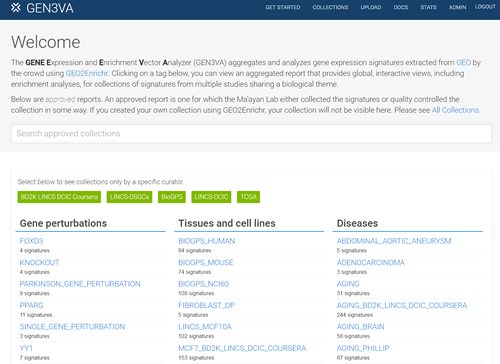
GEN3VA: aggregation and analysis of gene expression signatures from related studies
Gundersen et al (2016) in BMC Bioinformatics describes GENE Expression and Enrichment Vector Analyzer (GEN3VA), a web‐based system that enables the integrative analysis of aggregated collections of tagged gene expression signatures identified and extracted from GEO. Each tagged collection of signatures is presented in a report that consists of heatmaps of the differentially expressed genes; principal component analysis of all signatures; enrichment analysis with several gene set libraries across all signatures, which we term enrichment vector analysis; and global mapping of small molecules that are predicted to reverse or mimic each signature in the aggregate. They demonstrate how GEN3VA can be used to identify common molecular mechanisms of aging by analyzing tagged signatures from 244 studies that compared young vs. old tissues in mammalian systems. GEN3VA can be used to identify, aggregate, and analyze themed collections of gene expression signatures from diverse but related studies.
Citation: Gundersen GW, Jagodnik KM, Woodland H, Fernandez NF, Sani K, Dohlman AB, Ung PM, Monteiro CD, Schlessinger A, Ma'ayan A. GEN3VA: aggregation and analysis of gene expression signatures from related studies. BMC Bioinformatics. 2016 Nov 15;17(1):461. PMID: 27846806
Follow @BD2KLINCSDCICPublication Highlight | HMS LINCS Center
Posted on December 7th, 2016 by Sherry Jenkins
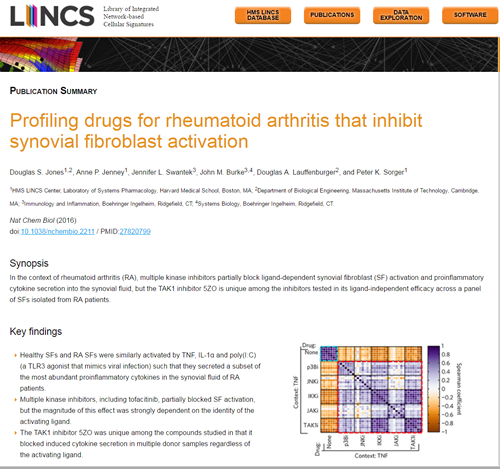
Profiling drugs for rheumatoid arthritis that inhibit synovial fibroblast activation
Jones et al (2016) in Nature Chemical Biology describes a new drug profiling study of relevance to rheumatoid arthritis. Explore the publication as well as the associated datasets available in the HMS LINCS Database (#20233, #20234, #20235).
Citation: Jones DS, Jenney AP, Swantek JL, Burke JM, Lauffenburger DA, Sorger PK. Profiling drugs for rheumatoid arthritis that inhibit synovial fibroblast activation. Nat Chem Biol. 2016 Oct 31. doi: 10.1038/nchembio.2211 PMID: 27820799
Follow @LINCSProgramBD2K-LINCS DCIC Summer Research Training Program in Biomedical Big Data Science
Posted on October 20th, 2016 by Sherry Jenkins
We are currently accepting applications for the BD2K-LINCS DCIC Summer Research Training Program in Biomedical Big Data Science, a research intensive ten-week training program for undergraduate and graduate students. The DCIC supports data science research focused on developing methods that would further extract knowledge from LINCS data by integrating LINCS data with other relevant resources. Summer fellows conduct faculty-mentored independent research projects within laboratories affiliated with the Center in the following areas: data integration, dynamic data visualization, machine learning, data harmonization, computational drug discovery, metadata and APIs, knowledge modeling, Bayesian networks and statistical mining.
How to Apply
Program Dates: June 5, 2017 - August 11, 2017
Presentation by our 2016 BD2K-LINCS DCIC Summer Fellow Katie Lin
DToxS Center
Posted on October 20th, 2016 by Sherry Jenkins

Members of the DToxS Center recently published in bioRxiv “Clinically-weighted transcriptomic signatures for protein kinase inhibitor associated cardiotoxicity”.
http://biorxiv.org/content/early/2016/09/19/075754
HMS LINCS Data Release
Posted on September 29th, 2016 by Sherry Jenkins

The HMS LINCS Center recently released three high-content immunofluorescence imaging datasets that characterize cell state and signaling pathway status in the MCF 10A breast cell line treated with EGF or selected kinase inhibitors (HMS LINCS Datasets #20265, #20266, and #20267).
Follow @LINCSProgramPress Release: Crowdsourcing for Scientific Discovery
Posted on September 23rd, 2016 by Sherry Jenkins

Mount Sinai Researchers Find Novel Ways to Analyze Data for Drug and Target Discovery
Avi Ma’ayan and his team (members of BD2K-LINCS DCIC) have crowdsourced the annotation and analysis of a large number of gene expression profiles from the National Center for Biotechnology Information’s (NCBI) Gene Expression Omnibus (GEO). More than 70 volunteers from 25 countries helped the Ma’ayan Lab analyze the data, enabling the identification of new associations between genes, diseases, and drugs. The Crowd Extracted Expression of Differential Signatures (CREEDS) web portal developed by the Ma’ayan Lab at Icahn School of Medicine at Mount Sinai contains the collections of processed gene, drug and disease signatures from GEO. An article published September 26 in the journal Nature Communications describes the crowdsourcing project. Read More
Wang Z, Monteiro CD, Jagodnik KM, Fernandez NF, Gundersen GW, Rouillard AD, Jenkins SL, Feldmann AS, Hu KS, McDermott MG, Duan Q, Clark NR, Jones MR, Kou Y, Goff T, et al [...] Ma'ayan A. Extraction and analysis of signatures from the Gene Expression Omnibus by the crowd. Nature Communications 2016 Sep 26;7:12846.
PMID: 27667448
Breast Cancer Browser
Posted on September 16th, 2016 by Sherry Jenkins
The HMS LINCS Center launched its Breast Cancer Browser, a data portal that aggregates and visualizes both published and unpublished datasets of significant interest to researchers studying breast cancer biology, drug response, and drug polypharmacology.
 Follow @LINCSProgram
Follow @LINCSProgramLINCS Consortium Meeting
Posted on August 31st, 2016 by Sherry Jenkins
Mark your calendars for the upcoming LINCS Consortium Face-to-Face Meeting that will be held on September 19-20, 2016 at the NIH Campus in Bethesda, MD. #LINCSDATA
Follow @LINCSProgramBD2K-LINCS DCIC Summer Research Training Program in Biomedical Big Data Science
Posted on August 12th, 2016 by Sherry Jenkins
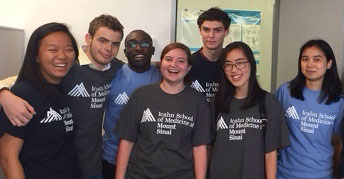
On the final day of the ten-week training program, the summer fellows in the BD2K-LINCS DCIC Summer Research Training Program in Biomedical Big Data Science presented their projects at the ISMMS SURP poster session as well as during a special LINCS webinar. Summer fellows conducted faculty-mentored independent research projects within laboratories affiliated with the Center in the following areas: data integration, dynamic data visualization, machine learning, data harmonization, computational drug discovery, metadata and APIs, knowledge modeling, Bayesian networks and statistical mining.
Program Description
2016 Summer Fellows and Research Projects
Big Data Science with the BD2K-LINCS Data Coordination and Integration Center
Posted on August 8th, 2016 by Sherry Jenkins
MOOC on Coursera
The BD2K-LINCS Data Coordination and Integration Center (DCIC) launched the second session of their MOOC on Coursera on August 8, 2016. This course covers various methods of analysis including: unsupervised clustering, gene-set enrichment analyses, interactive data visualization, and supervised machine learning with application to data from the Library of Integrated Network- based Cellular Signature (LINCS) program, and other relevant Big Data from high content molecular omics data and phenotype profiling of mammalian cells.
Go to Coursera Course
Follow @BD2KLINCSDCICALS Research Suggests Stem Cells Be 'Aged' to Speed Progress Toward Finding Treatments
Posted on July 7th, 2016 by Sherry Jenkins
Press Release
Click here for the full press release about a recent study led by Clive Svendsen PhD (NeuroLINCS), and Ritchie Ho PhD that was published online July 18 in the journal Nature Neuroscience.
Publication: Ho R, Sances S, Gowing G, Amoroso MW, O'Rourke JG, Sahabian A, Wichterle H , Baloh RH, Sareen D, Svendsen CN. ALS disrupts spinal motor neuron maturation and aging pathways within gene co-expression networks. Nat Neurosci. 2016 Sep 19(9):1256-67.
PMID: 27428653
Connectivity Map Challenge
Posted on June 16th, 2016 by Sherry Jenkins
By the Crowd Innovation Lab at Harvard, the Broad Institute, and NIH LINCS Program

The LINCS Center for Transcriptomics, in partnership with the Crowd Innovation Lab at Harvard Business School, is launching their first challenge, “Infer the Transcriptome”. Contestants will be provided with a large dataset of ~100,000 gene expression profiles on which to train an inference model. Models will be scored based on their accuracy in predicting gene expression values for non-landmark genes in a separate test dataset. The contest format will be a 2-week marathon featuring a continuously updated leaderboard. To determine winners, each contestant’s best model will be scored on its performance on a holdout dataset.
Follow @LINCSProgramData Standards Update
Posted on June 2nd, 2016 by Sherry Jenkins
Metadata Standards – New Versions Released
Current Versions of Standards Released: 5-13-16
Editorial in Science Translational Medicine
Posted on May 23rd, 2016 by Sherry Jenkins
Reproducibility will only come with data liberation
In a recent editorial in Science Translational Medicine, Mohammed AlQuraishi and Peter Sorger from the HMS LINCS Center make the case for improving accessibility and usability of published experimental data of all data types.
AlQuraishi M, Sorger PK. Reproducibility will only come with data liberation. Sci Transl Med. 2016 May 18;8(339):339ed7. PMID: 27194726

SEP-L1000
Posted on May 20th, 2016 by Sherry Jenkins
Side effect prediction based on L1000 data
A web portal for browsing and searching predictive small-molecule/ADR connections

SEP-L1000 serves the results of the predicted ADRs for the drugs and small-molecule compounds profiled in the LINCS L1000 project. A network of predictive ADRs was constructed based on their drug similarity and visualized using a stacked bubble chart. Each drug and ADR has a dedicated page with a list of the relevant predictions and external links.
Wang Z, Clark NR, Ma’ayan A. Drug-induced adverse events prediction with the LINCS L1000 data. Bioinformatics 2016. PMID: 27153606
Follow @LINCSProgramGR Metrics Calculator and Browser
Posted on May 20th, 2016 by Sherry Jenkins
Drug-response studies play an important role in both preclinical and clinical research, but such studies are complicated by differences in cell growth rates across samples and conditions. To improve the value and reliability of such studies, new metrics for parameterizing drug response were developed and published in Nature Methods by the HMS LINCS Center. The online GR tools were developed by the BD2K-LINCS Data Coordination and Integration Center.
Hafner M, Niepel M, Chung M, Sorger PK. Growth rate inhibition metrics correct for confounders in measuring sensitivity to cancer drugs. Nature Methods 2016. PMID: 27135972
Follow @LINCSProgramHMS LINCS Center: Growth Rate Inhibition Metrics Correct for Confounders in Measuring Sensitivity to Cancer Drugs
Posted on May 17th, 2016 by Sherry Jenkins
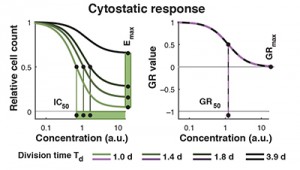
The HMS LINCS Center’s most recent study (Hafner, Niepel et al. (2016)), which describes new "GR" metrics that account for variation in cell growth when quantifying cellular dose response to perturbagens, was published in Nature Methods. Explore the publication in more detail, or, through the online GR Browser developed in collaboration with the BD2K-LINCS DCIC, calculate GR metrics from your own data and browse several available LINCS dose-response datasets.
Hafner M, Niepel M, Chung M, Sorger PK. Growth rate inhibition metrics correct for confounders in measuring sensitivity to cancer drugs. Nature Methods 2016. PMID: 27135972
Follow @LINCSProgramCover of Molecular and Cellular Proteomics: Phosphosignatures from the P100 Sentinel Assay
Posted on May 2nd, 2016 by Sherry Jenkins
A publication from the LINCS Proteomic Characterization Center for Signaling and Epigenetics was highlighted on the cover of the May 2016, 15 (5) issue of Molecular and Cellular Proteomics.
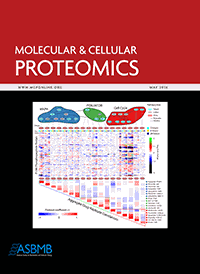
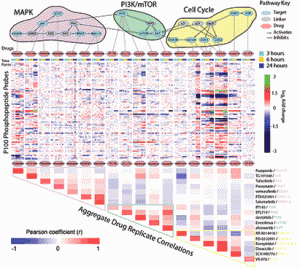
A set of kinase inhibitors directed at known pathways (top) were introduced to cells. Phosphosignatures from the novel P100 sentinel assay are shown after 3, 6, or 24 hours of treatment (middle). Correlation of all samples demonstrates strong signals in the assay, and off-diagonal correlation reinforces the hypothesized modularity of the pathway into MAPK, PI3K/mTOR, and Cell Cycling modules (bottom).
Abelin JG, Patel J, Lu X, Feeney CM, Fagbami L, Creech AL, Hu R, Lam D, Davison D, Pino L, Qiao JW, Kuhn E, Officer A, Li J, Abbatiello S, Subramanian A, Sidman R, Snyder EY, Carr SA, Jaffe JD. Reduced-representation phosphosignatures measured by quantitative targeted MS capture cellular states and enable large-scale comparison of drug-induced phenotypes. PMID: 26912667
Follow @LINCSProgramNIH LINCS Program on Social Media
Posted on April 25th, 2016 by Sherry Jenkins
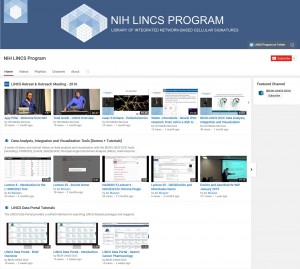
Please follow the NIH LINCS Program on social media for information on the consortium’s latest news and data releases! NIH LINCS Program YouTube channel
Follow @LINCSProgramHMS LINCS Center Updates
Posted on April 6th, 2016 by Sherry Jenkins
Dose response metrics were released for the drug combinations tested in the LINCS Pilot Phase Joint Project and analyzed by imaging by the HMS LINCS Center and by L1000 from the Broad LINCS Center.

Three datasets were released that assess the effects of cell plating density on the calculation of dose-response metrics for 6 breast cancer cell lines treated with 12 different kinase inhibitors. See HMS LINCS Dataset #20258 for a comparison of metrics based on standard, cell count-based calculations and metrics based on using newly-derived, growth rate-independent calculations.
New Feature for LINCS Tools: ‘Quick Start with LINCS’
Posted on March 28th, 2016 by Sherry Jenkins
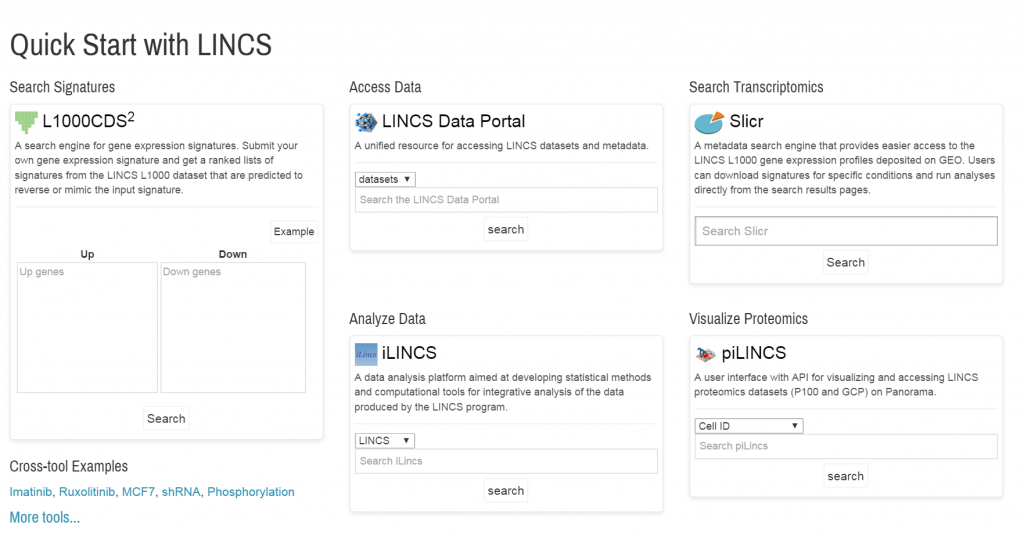
The ‘Quick Start with LINCS‘ analysis tool feature enables users to search signatures (L1000CDS2), access data (LINCS Data Portal), analyze data (iLINCS), search transcriptomics (Slicr) and visualize proteomics (piLINCS).
NeuroLINCS Center Releases New Tool: AChroMap
Posted on March 28th, 2016 by Sherry Jenkins
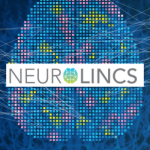 AChroMap (accessible chromatin mapper of transcriptional regulators) is a data integration tool for transcriptomic and epigenomic data. This tool generates a list of enriched motifs in open chromatin regions (as assayed by ATAC-seq or DNAseH) for a given set genes. The foreground list of genes are differentially expressed or highly expressed genes and the background list of genes are the rest of the genes in the transcriptomic experiment.
AChroMap (accessible chromatin mapper of transcriptional regulators) is a data integration tool for transcriptomic and epigenomic data. This tool generates a list of enriched motifs in open chromatin regions (as assayed by ATAC-seq or DNAseH) for a given set genes. The foreground list of genes are differentially expressed or highly expressed genes and the background list of genes are the rest of the genes in the transcriptomic experiment.
LINCS Outreach Meeting 2016 - Video Archive
Posted on March 23rd, 2016 by Sherry Jenkins
Molecular Medicine Tri-Conference 2016
Posted on February 5th, 2016 by Sherry Jenkins
On March 8, 2016, as part of the BD2K-LINCS DCIC’s community outreach efforts, Avi Ma’ayan PhD and Stephan Schurer PhD will present in the Informatics channel at the Molecular Medicine Tri-Conference 2016 in San Francisco, CA.

Bioinformatics for Big Data
L1000CDS2: LINCS L1000 Characteristic Direction Signature Search Engine Predicts Kenpaullone as a Potential Therapeutic for Ebola
Avi Ma’ayan, PhD, Icahn School of Medicine at Mount Sinai
Learn moreIntegrated Informatics Driving Translational Research and Precision Medicine
Rational Data-Driven Development of Novel Poly-Pharmacology Small Molecules
Stephan Schurer, PhD, Miller School of Medicine, University of Miami
Learn moreLINCS Outreach Meeting 2016
Posted on February 4th, 2016 by Sherry Jenkins
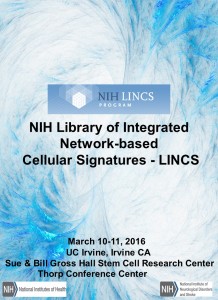
General Info | Agenda | Registration | General Info
The Library of Integrated Network-based Cellular Signatures (LINCS) program aims to create a network-based understanding of biology by cataloging changes induced by exogenous perturbations on cellular processes through the lens of molecular and morphological profiling signatures. By generating, integrating, and publicly releasing data and tools that indicate how cells respond to various genetic and environmental stressors, the LINCS project will help us gain a more detailed understanding of cell pathways and aid efforts to develop therapies that might restore perturbed pathways and networks to their normal states. Come join us at our first ever Outreach Meeting to see examples of LINCS in action and learn how to effectively work with these unprecedented datasets.
Confirmed Speakers:
- Walter Koroshetz, NINDS
- Zak Kohane, Harvard Medical School
- Henry Rodriguez, NCI
- Jane Roskams, Allen Institute for Brain Science
- Fred Gage, The Salk Institute
- Gustavo Stolovitzky, IBM
- Phil Nelson, Google
- Trey Ideker, UCSD
Meet investigators from the LINCS Data and Signature Generation Centers and the BD2K-LINCS Data Coordination and Integration Center to establish collaborations!
Present your work at our poster session! A limited number of travel fellowships are available.
Systems Biology Data Science Symposium 2016
Posted on January 25th, 2016 by Sherry Jenkins
On January 19-20, 2016, the first annual Systems Biology Data Science Symposium (SBDSS 2016) at the University of Miami brought together the BD2K-LINCS Data Coordination and Integration Center, local researchers, and outside experts who apply or develop computational systems biology resources. In presentations, a poster reception and several working sessions, the DCIC showcased tools/resources and scientific projects, connected developers with users, and initiated new collaborations.
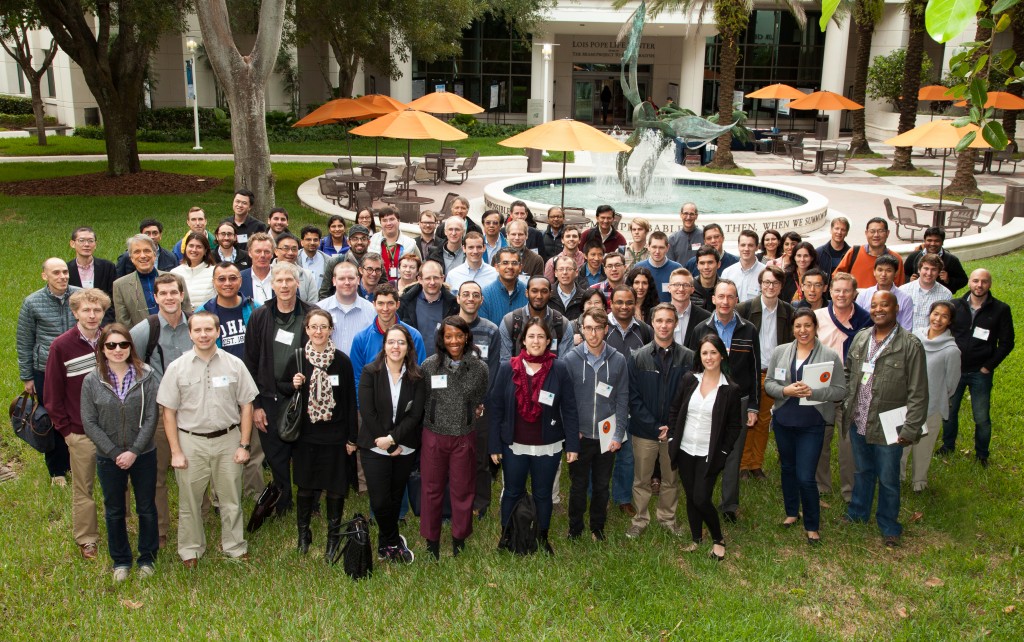
Day 1 Presentations:
Keynote Address: Overcoming Cancer Cell Heterogeneity through Epigenetic Therapies
Speaker: Stephen D. Nimer MD, University of Miami
The NIH BD2K Initiative: How it Hopes to Impact Biomedical Research
Ajay Pillai, PhD, Program Director – National Human Genome Research Institute (NHGRI), NIH Program
From Big Data to Knowledge – Experiences in Rare Disease Genomics
Stephan Zuchner, MD, PhD, University of Miami
LINCS Computational Pipelines for Drug Discovery
Avi Ma’ayan, PhD, Icahn School of Medicine at Mount Sinai | BD2K-LINCS DCIC
Uncovering Perturbation Mode of Action with LINCS Data and Tools
Mario Medvedovic, PhD, University of Cincinnati | BD2K-LINCS DCIC
L1K++: Fast and Accurate Pipeline for Processing L1000 Gene Expression Data
Ka Yee Yeung, PhD, University of Washington
Target Predictions using LINCS Perturbation Data
Ziv Bar-Joseph, PhD, Carnegie Mellon University
Disease and Perturbagen Posttranslational Signatures across Multiple Signaling Pathways in Lung Cancer Cell Lines: Analysis of TMT Data Published in PhosphoSitePlus (PSP)
Peter Hornbeck, PhD, Cell Signaling Technology
Building a Culture of Model-driven Drug Discovery at Merck
Chris Waller, PhD, Merck & Co.
Modeling Spinal Cord Injury using Knowledge-Based and Data Driven Approaches
Vance Lemmon, PhD, University of Miami
A Next Generation Connectivity Map: L1000 Platform and the First 1,000,000 Profiles
Aravind Subramanian, PhD, Broad Institute of MIT & Harvard
Systematic Discovery of Drug Targets and Disease Indications using Genetics and Connectivity Map
Pankaj Agarwal, PhD, GlaxoSmithKline
For information about the SBDSS 2016, including the full agenda, click here.
New LINCS L1000 Tool and Updated Release of LINCS Data Portal
Posted on December 22nd, 2015 by Sherry Jenkins

The BD2K-LINCS DCIC recently released a new tool called Slicr which is a metadata search engine that searches for LINCS L1000 gene expression profiles and signatures matching users' input parameters. It features download of selected search results as csv files in a zipped folder and visualization of selected results in a 3D scatter plot using PCA or MDS.

The BD2K-LINCS DCIC recently released an updated version of the LINCS Data Portal that provides a unified interface for searching LINCS dataset packages and reagents
New Release of Enrichr
Posted on November 19th, 2015 by Sherry Jenkins
 In this new release of Enrichr, the BD2K-LINCS DCIC updated their ChIP-X Enrichment Analysis (ChEA) database with gene sets extracted from forty new studies. The previous version is now in the ‘Legacy’ category for provenance.
In this new release of Enrichr, the BD2K-LINCS DCIC updated their ChIP-X Enrichment Analysis (ChEA) database with gene sets extracted from forty new studies. The previous version is now in the ‘Legacy’ category for provenance.
They also added a new gene set library created from the database of Genotypes and Phenotypes (dbGaP), as well as two new libraries with the up- and down-regulated genes from the L1000 Connectivity Map chemical perturbation profiles from the LINCS Center for Transcriptomics. The previous version of the Connectivity Map Affymetrix data was renamed to Old CMAP.
Please visit the What’s New? section of the Enrichr website for more details about the new release.
LINCS in the News
Posted on November 19th, 2015 by Sherry Jenkins
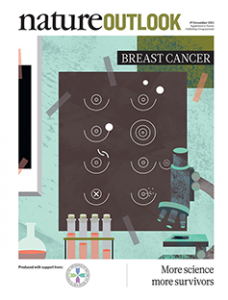
Genetics: Big Hopes for Big Data
Jill U. Adam
Nature 527, S108–S109 (19 November 2015) doi:10.1038/527S108a. Published online 18 November 2015
BD2K-LINCS DCIC | Accepting Applications for 2016 Summer Research Training Program
Posted on November 5th, 2015 by Sherry Jenkins
 The BD2K-LINCS DCIC Summer Research Training Program in Biomedical Big Data Science is a research intensive ten-week training program for undergraduate and graduate students interested in participating in cutting edge research projects aimed at solving data-intensive biomedical problems. Summer fellows conduct faculty-mentored independent research projects within laboratories affiliated with the Center in the following areas: data integration, dynamic data visualization, machine learning, data harmonization, computational drug discovery, metadata and APIs, knowledge modeling, Bayesian networks and statistical mining.
The BD2K-LINCS DCIC Summer Research Training Program in Biomedical Big Data Science is a research intensive ten-week training program for undergraduate and graduate students interested in participating in cutting edge research projects aimed at solving data-intensive biomedical problems. Summer fellows conduct faculty-mentored independent research projects within laboratories affiliated with the Center in the following areas: data integration, dynamic data visualization, machine learning, data harmonization, computational drug discovery, metadata and APIs, knowledge modeling, Bayesian networks and statistical mining.
In summer session 2016, our research training program will be offered at the three sites affiliated with our NIH-funded Center:
Ma’ayan Laboratory of Computational Systems Biology | Icahn School of Medicine at Mount Sinai
Medvedovic Laboratory for Statistical Genomics and Systems Biology | University of Cincinnati
Schurer Laboratory in the Center for Computational Science | University of Miami
Application Deadline: March 4, 2016 at 11:00 PM ET
For the program description and information on how to apply, click here.
BD2K-LINCS DCIC | Systems Biology Data Science Symposium | January 19-20, 2016
Posted on September 23rd, 2015 by Sherry Jenkins
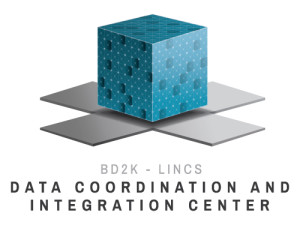 The BD2K-LINCS Data Coordination and Integration Center and the University of Miami will host a two-day Systems Biology Data Science Symposium on January 19-20, 2016 at the University of Miami.
The BD2K-LINCS Data Coordination and Integration Center and the University of Miami will host a two-day Systems Biology Data Science Symposium on January 19-20, 2016 at the University of Miami.
On January 19-20, 2016, the first annual Systems Biology Data Science Symposium (SBDSS 2016) at the University of Miami will bring together the BD2K-LINCS Data Coordination and Integration Center, local researchers, and outside experts who apply or develop computational systems biology resources. In presentations, a poster reception and several working sessions, the DCIC showcased tools/resources and scientific projects, connected developers with users, and initiated new collaborations.
Details: http://lincs-dcic.org/#/2016-data-science-symposium
New Course: Big Data Science with the BD2K-LINCS Data Coordination and Integration Center
Posted on September 17th, 2015 by Sherry Jenkins
The BD2K-LINCS Data Coordination and Integration Center (DCIC) launched this MOOC on Coursera on September 15, 2015 which covers various methods of analysis including: unsupervised clustering, gene-set enrichment analyses, data visualization, and supervised machine learning applications to LINCS data.
Go to Course: https://www.coursera.org/course/bd2klincs
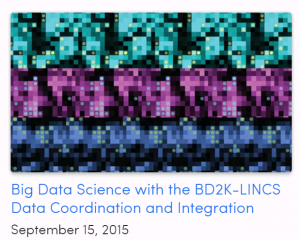
Course Summary
The BD2K-LINCS Data Coordination and Integration Center (DCIC) is commissioned to organize, analyze, visualize and integrate this data with other publicly available relevant resources. In this course we will introduce the various Centers that collect data for LINCS, describing the experimental data procedures and the various data types. We will then cover the design and collection of metadata and how metadata is linked to ontologies. We will then cover basic data processing and data normalization methods to clean and harmonize LINCS data. This will follow with a discussion about how the data is served as RESTful APIs and JSON, and for this we will cover concepts from client-server computing. Most importantly, the course will focus on various methods of analysis including: unsupervised clustering, gene-set enrichment analyses, data visualization, and supervised machine learning applications to LINCS data and other relevant Big Data from molecular biomedicine.
New Resource: L1000 Characteristic Direction Signature Search Engine (L1000CDS2)
Posted on August 17th, 2015 by Sherry Jenkins
L1000CDS2, developed by Ma’ayan Laboratory for the BD2K-LINCS DCIC, queries gene expression signatures against the LINCS L1000 to identify and prioritize small molecules that can reverse or mimic the observed input expression pattern.
Data Standards Update
Posted on August 17th, 2015 by Sherry Jenkins
The Data Standards page has been updated to reflect the most recent standards releases in LINCS Production Phase 2.
Data Releases: DToxS, HMS LINCS, LINCS Center for Transcriptomics, LINCS PCCSE, and NeuroLINCS
Posted on August 13th, 2015 by Sherry Jenkins
LINCS centers recently released the first wave of data that includes RNA-seq, L1000, P100, SWATH, Cell Viability and Growth, KinomeScan, and RPPA profiling human cell lines treated with many drugs and small molecules.
The Data Releases page describes the collections of data released and planned to be released to the public by the LINCS Consortium.
Workshop: Interdisciplinary Approaches to Biomedical Data Science Challenges: SAMSI Innovations Lab | July 20-24, 2015
Posted on August 6th, 2015 by Sherry Jenkins
Stephan Schurer PhD, BD2K-LINCS Data Coordination and Integration Center, served as a mentor in this workshop to guide scientists in the formation of interdisciplinary projects aimed at developing models, methods, and approaches to overcome biomedical data science challenges. During the course of the workshop, participants were exposed to LINCS resources. The workshop took place from July 20 to 24, 2015 at the Hamner Conference Center at the NC Biotechnology Center, 15 TW Alexander Drive in Research Triangle Park, North Carolina.
Workshop: Genomic and Computational Approaches for Biomarker and Drug Discovery | June 19, 2015
Posted on April 13th, 2015 by Sherry Jenkins
The purpose of this workshop is to bring together (Library of Integrated Network-based Cellular Signatures) LINCS scientists and scientists from the alcohol research community to explore how LINCS resources can facilitate identification of druggable targets and novel and/or repurposed compounds for the treatment of alcohol dependence.
Date | Time | Location
- Friday, June 19th, 2015 from 2-5 PM
- Grand Hyatt (Room: Travis C/D), San Antonio, TX
Register
- Please RSVP by May 1st, 2015 to Matthew Reilly at reillymt@mail.nih.gov
- Space is limited to 50 participants
Agenda
Welcome and Opening Remarks
Matthew Reilly PhD and Ajay Pillai PhD, NIH
Hands-on Session: Web Apps and Tools
Session Leaders: Avi Ma’ayan PhD, BD2K-LINCS Data Coordination and Integration Center and Aravind Subramanian PhD, LINCS Center for Transcriptomics
This session will consist of a hands-on demonstration of currently available web apps and tools from the LINCS Common Fund program. Participants will learn how to apply these tools to their own research programs. Please bring your laptop computer and gene expression or other genomic data to analyze.
Additional Information
- Please register and create a lincscloud.org account before the workshop.
- Your genomics datasets you bring to analyze should be formatted either as (1) official gene symbols or (2) Affymetrix U133A probe IDs. Some of the web tools require a list of both up-regulated and down-regulated gene lists and some of the tools only accept gene symbols.
- Because the majority of the LINCS datasets use human cell lines, gene sets should be annotated for mammalian species.
- When you RSVP for the workshop, please indicate your area of expertise: genomics, computational or other.
- Also, if you already have experience with working with any of the LINCS tools, you are welcome to submit questions/concerns, suggestions or other feedback in advance of the workshop. You can submit your questions etc., to the workshop organizer: Matthew Reilly at reillymt@mail.nih.gov.
Administrative Supplements to Extend the Scope and Reach of LINCS Datasets
Posted on February 28th, 2015 by Sherry Jenkins
This notice (NOT-RM-15-102) announces an opportunity to request administrative supplements to existing NIH research grants, to support generation of new data that will also advance the goals of the LINCS program. Please visit the funding opportunities page for more details.
Call for External Collaborations with the BD2K-LINCS Data Coordination and Integration Center
Posted on February 24th, 2015 by Sherry Jenkins
The BD2K-LINCS DCIC announces a call for applications for the next round of external data science research projects. The call is for two-year projects that would leverage LINCS generated data through application of novel computational methods. For more information, please visit: http://www.lincs-dcic.org/#/edsr. Refer to the funding opportunities page for more details.
LINCS Cell Line Data Integrated into ChEMBL
Posted on February 20th, 2015 by Sherry Jenkins
CHEMBL now provides CHEMBL IDs for all cell lines stored in their database and also cross references to the LINCS project.
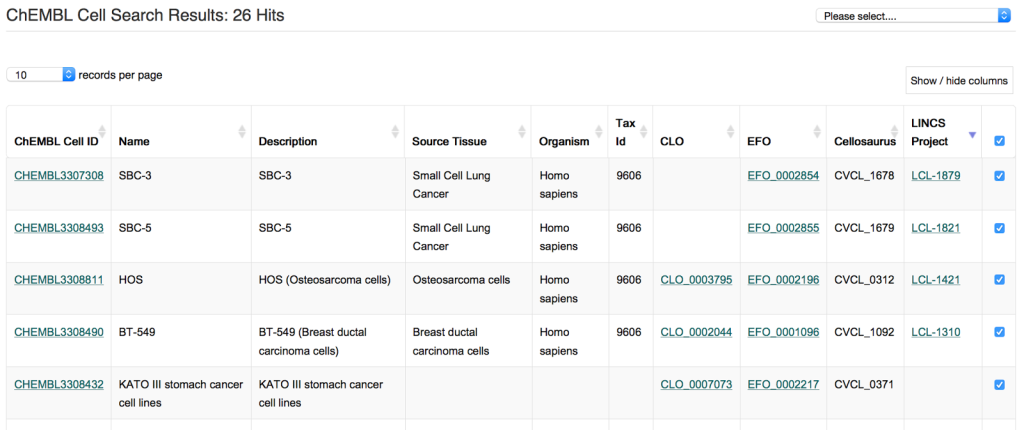
LINCS Investigators Present at the AACR Special Conference on Computational and Systems Biology of Cancer
Posted on February 8th, 2015 by Sherry Jenkins
February 8-11, 2015
The Fairmont San Francisco
San Francisco, California
Conference Co-Chairpersons
Andrea Califano, Columbia University, New York, New York
Brenda J. Andrews, University of Toronto, Toronto, Ontario, Canada
Peter K. Jackson, Stanford University, Stanford, California
Spatial Systems Biology and Cancer
Joe W. Gray, MEP LINCS Center
Using Single-cell Pharmacology to Improve Drug Design
Peter K. Sorger, HMS LINCS Center
Lean Data Integration Strategy in Cancer Systems Biology and Systems Pharmacology
Avi Ma’ayan, BD2K-LINCS Data Coordination and Integration Center
Transcriptional Landscape of Drug Response Guides the Design of Specific and Potent Drug Combinations
Marc Hafner, HMS LINCS Center



